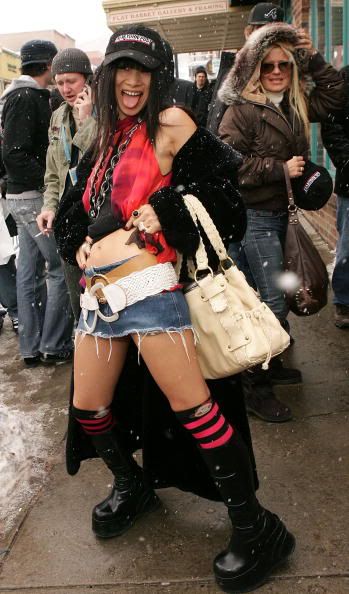


Fashion victim is a term - claimed to have been coined by Oscar de la Renta[1] - that is used to identify a person who is unable to identify commonly recognized boundaries of style.
Fashion victims are victims because they are vulnerable to faddishness and materialism, two of the widely recognized excesses of fashion, and consequently are at the mercy of society's prejudices or of the commercial interest of the fashion industry, or of both. According to Versace, "When a woman alters her look too much from season to season, she becomes a fashion victim."[2]
Faddishness
A fad is an intense but short-lived fashion trend. Fads are also by their nature at the extreme range of currently acceptable style, which means they commonly cross the line from the sublime to the ridiculous. Fashion victims can be seen to have crossed this line. (See Sarah Jessica Parker and Sex in the City.)Materialism
Keeping up with fashion is often very expensive. Expensive clothes signal that the wearer is financially successful, but they are not necessarily cool or fashionable.[3]Designer branding is sometimes associated with a higher quality of manufacture and a more expensive price. The ownership and display of such products of quality is frequently marketed to suggest that the wearer will automatically embody a personal characteristic of quality by association. Designers have identified this fact and in some cases are able to exploit this to the extent that prices can be escalated to surprising proportions without reference to the cost of manufacture. Extreme examples of this type of branding are found among accessory manufacturers such as Versace, Gucci and Burberry, scent manufacturers such as Chanel and Guerlain and watch manufacturers such as Rolex and Bvlgari.[citation needed]
Fashion victims, by their characteristic inability to recognize boundaries, may aspire to the extreme end of what is available, seeking expensive products (or copies of these products), believing that the outward display of such items will draw admiration in proportion to their actual or apparent cost. Because of this, "the term 'fashion victim' became the ultimate insult to the aspirational."[4]
References- ^ According to John Fairchild, "[Oscar and I] were sitting at the Caravelle and Oscar looked around and said, 'These people are absolute hell, they look like fashion victims,' and that was the first time anyone had used that expression." Coleridge, Nicholas (1989). The Fashion Conspiracy. HarperCollins. 0060916362.
- ^ Agins, Teri (2000). The End of Fashion: How Marketing Changed the Clothing Business Forever. Harper Paperbacks. pp. 116. 0060958200.
- ^ Michelle Lee notes that in order to appear casually well-dressed, shoppers pay extra for designers to "sew on decorative patches, slash gaping holes into the knees of jeans and fray the hems." Lee, Michelle (2003). Fashion Victim: Our Love-Hate Relationship with Dressing, Shopping, and the Cost of Style. Broadway. 0767910486.
- ^ Arnold, Rebecca (2001). Fashion, Desire, and Anxiety. I B Tauris & Co Ltd. pp. 10. 1860645550.
Source : http://en.wikipedia.org/wiki/Fashion_victim
Tidak ada komentar:
Posting Komentar